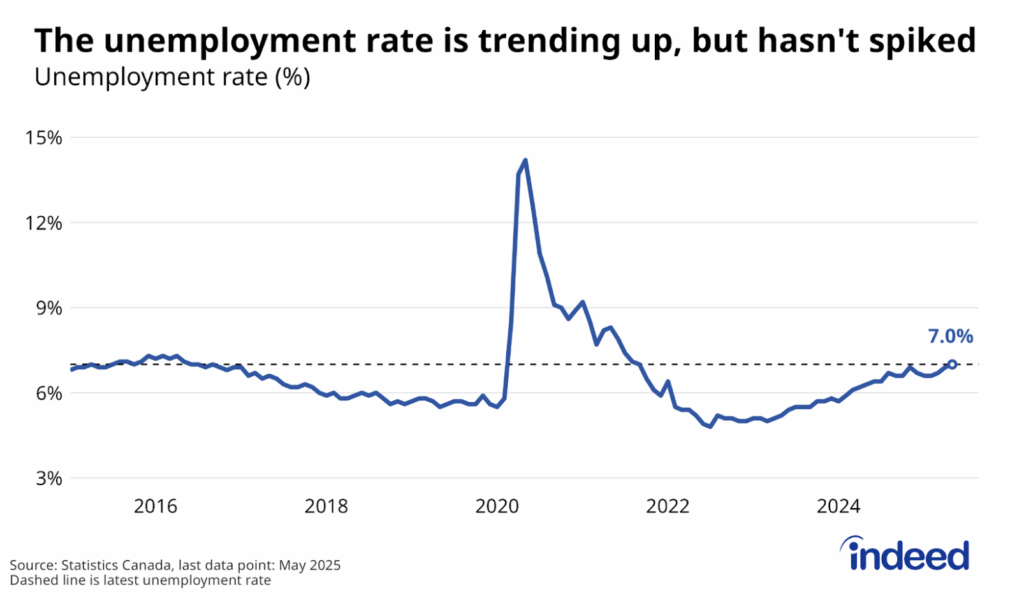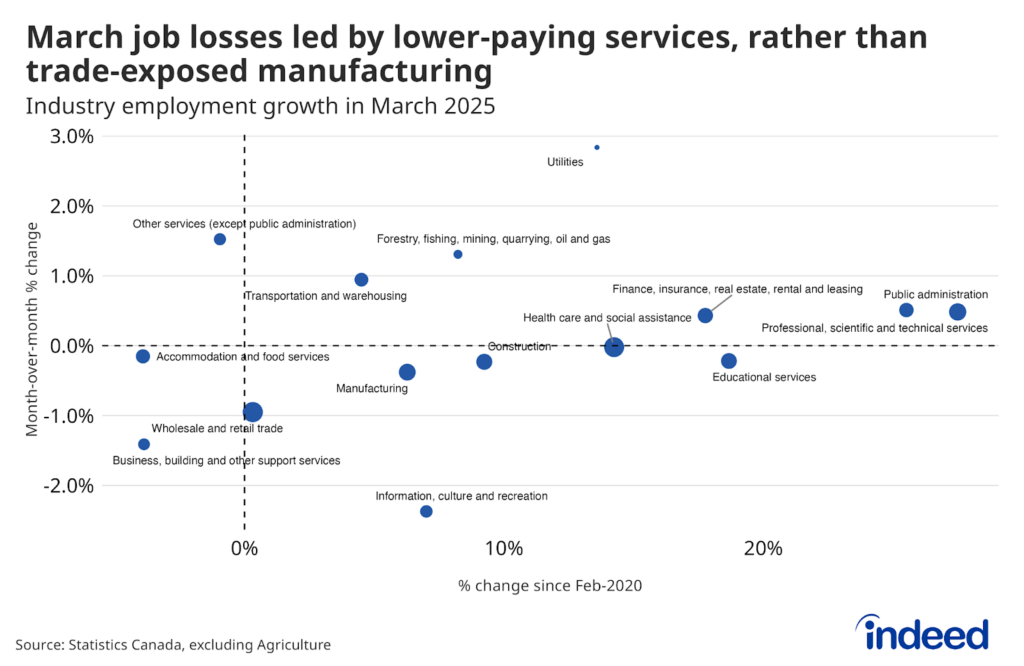Key Points
- Relative job seeker interest per post on Indeed’s Canada site is down substantially since the start of the pandemic in six large job categories, including construction, loading and stocking, cleaning and sanitation, food preparation and service, retail, and customer service.
- By contrast, clicks per posting are up in a range of mid- and higher-paying fields compared with the economy-wide average, including education, therapy, and IT operations.
- Through early November, neither the vaccine rollout nor the wind-down of the Canada Recovery Benefit had done much to boost the popularity of jobs that declined earlier, which means employers may have to hike wage offers to attract candidates.
Job postings in several areas of the Canadian economy have experienced substantial declines in relative job seeker interest since the start of the pandemic. We track these shifts, updating earlier analysis, by monitoring the evolution of relative job seeker interest in different fields, measured by clicks per job posting on Indeed’s Canada site in different occupational groups compared with the economy-wide average.
Relative job seeker interest per post on Indeed — shortened here to relative interest — provides an indication of the ease employers in different segments of the economy have at capturing job seeker attention. The more clicks a field’s job postings receive, the more candidates are potentially available to fill open positions. At the same time, relative interest can shift because of changes in employer demand. If certain types of job postings rise faster than others, relative interest per post will fall because, on average, individual postings will get fewer clicks even without changes in job seeker click activity.
Overall, relative interest is down substantially in postings of six large, generally lower-paying, non-remote occupational groups. In most cases, the drops were driven by declines in both the share of total job seeker clicks going to these fields, as well as outsized increases in employer demand. Meanwhile, several mid- and higher-paying fields have gained in relative job seeker popularity.
Three fields related to manual labour saw the largest drops in relative job seeker interest
Job postings plunged across the Canadian economy at the onset of the pandemic, but hiring appetite rebounded fairly quickly for certain jobs. Among these were loading and stocking, cleaning and sanitation, and construction.
However, it wasn’t long before job seeker interest in these types of roles started lagging the rebound in demand. In fact, the share of Canadian job seeker clicks on job postings in these fields started to decline even as job postings rose. The result was significant declines in clicks per posting compared with the economy-wide average. By September 2020, relative interest in all three fields was down 30% or more from pre-pandemic levels after adjusting for seasonal factors.
A lot has changed in the Canadian labour market since mid-2020, but the shift in relative interest away from these positions has persisted. As of November 12, relative interest in cleaning and sanitation postings was down 32% from February 1, 2020, 34% in loading and stocking, and 35% in construction. For the first two, the changes mean the typical posting in these fields no longer receives substantially more clicks than the average Canadian job ad on Indeed, to only a little more than average. Meanwhile, postings in construction went from exceeding to lagging the economy-wide clicks-per-posting average.
Relative job seeker interest in certain service sector postings has also slipped
Clicks per postings compared with the economy-wide average have also fallen in several major service sector job categories, albeit less than the fields above. As of November 12, relative interest in customer service had dropped 10% from its pre-pandemic level, while retail positions were down 15% and food preparation and service 22%.
The relative popularity of job postings in these areas didn’t fall all at once. In particular, relative interest in food preparation and service postings has fluctuated, which includes a decline this past summer during the vaccine-led reopening when job seeker interest didn’t keep up with a surge in demand for food services workers.
The drop in relative interest in customer service has been more gradual. Customer service postings still receive more clicks than the typical Canadian job ad, but the gap has narrowed, primarily reflecting a surge demand for workers that has outpaced the economy-wide increase in job postings.
Where has job seeker interest gone instead?
At the other end of the spectrum, clicks per posting have risen compared with the economy-wide average in a range of mid-, and higher-wage areas. Three larger fields where postings have gained in relative popularity include education and instruction, therapy, and IT operations and helpdesk. Relative interest in postings in all three has jumped at least 37% since the start of the pandemic.
For the most part, these increases in relative interest don’t reflect lagging demand. Job postings in these areas have grown at, or a tad less than the economy-wide trend. More noticeable has been shifts in job seeker interest toward these fields, boosting their shares of overall Canadian click activity and, as a result, their relative clicks per posting compared with the average job ad on Indeed.
Can higher wages revive job seeker interest in areas that have lost ground?
Two general patterns are apparent across the fields where postings have substantially lost relative interest. First, they tend to have lower pay. Except for construction, the average posted wage on Indeed of jobs in these areas ranks in the bottom third of all Canadian occupational groups. Second, onsite work is required for nearly all these positions. Customer service is the only group where job postings on Indeed specify remote work with some regularity.
Throughout the pandemic, several unique factors may have contributed to the declines in popularity in these areas. These include ongoing COVID-19 risks, expanded jobless benefits, and elevated household savings. At the same time, through early November, neither the availability of vaccines nor the end of the Canada Recovery Benefit (CRB) in late October have done much to lift relative interest back toward where it was before the pandemic.
It’s possible vaccination and the end of the CRB haven’t had enough time to play out, especially when COVID-19 remains an ongoing source of uncertainty. Nonetheless, if the current situation persists, many employers will be asking what adjustments they need to make to attract job seekers.
Signs of higher wage growth, especially in the fields that have lost relative popularity, remain a key trend to watch for. Statistics Canada’s Job Vacancy and Wage Survey asks employers about the wages set for existing job openings. Between the second quarter of 2019 and the same period this year, growth of average offered wages in occupations commonly found in areas that have dropped in relative interest have been mixed compared with the rest of the economy.

Over the two years through June, offered wages for cashiers, trades helpers and construction labourers, food and beverage service workers, and retail salespersons grew at a similar pace to the 7.3% increase seen in the rest of the economy. Meanwhile, wages tied to vacancies for cleaners and occupations in industrial and construction trades, climbed more elsewhere. On the flip side though, offered wages for customer service representatives, chefs and cooks, and shelf stockers lagged the economy-wide average. Should the balance between job seeker interest and employer demand stay the same, employers struggling to fill vacancies will have to weigh whether major shifts in compensation are in order.
Methodology
In this post, we track how relative job seeker interest — clicks per posting in various occupational groups on Indeed’s Canada site relative to economy-wide clicks per posting — has changed since the start of the pandemic. This post focuses on how relative interest has evolved in areas of the Canadian economy that accounted for at least 0.7% of Canadian job postings during the week of November 12, 2021. Data are changes in the 28-day average of relative interest of postings in each field between February 1, 2020, and November 12, 2021.






